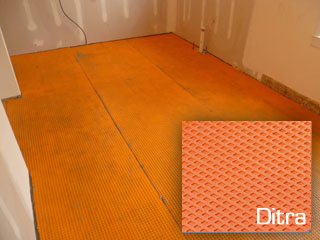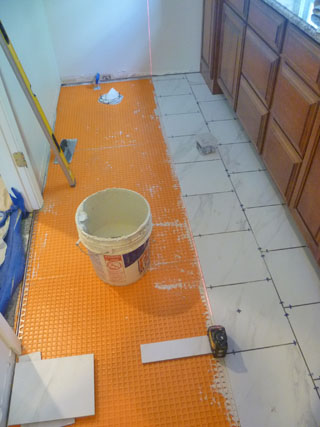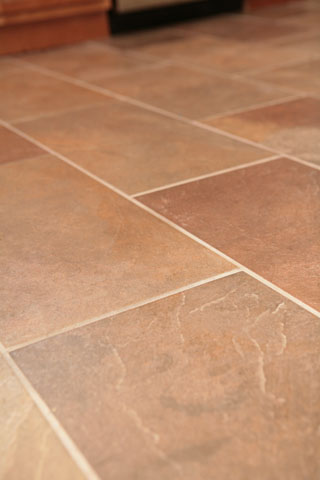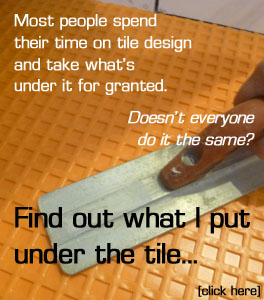What’s Under the Tile?
When considering a tile project there are two main parts to consider: 1) the tile design and layout AND 2) what goes under it. Most people spend the majority of their time on #1 and take #2 for granted. Doesn’t every tile contractor do it the same? No, they don’t. Let’s explore some of the differences and what goes under my tile…
TWO PROBLEMS TO SOLVE
Installing tile takes some important preparations because of two issues: a) Your house moves and b) Tile needs support. These are two very different issues that have to be looked at with each project.
I. YOUR HOUSE MOVES
 Your house is not a constant. It is continually expanding and contracting as temperature and humidity levels change. Some substances, like concrete, are affected less than others, like wood, but it’s always changing. This is the enemy of tile! If you lay tile directly over a wood floor, within a year of weather changes it may be full of cracks because tile doesn’t move. Tile and grout are not flexible. While it’s true they may have a tiny amount of change themselves, compared to wood they are quite stable. If the wood below starts to move we have to do something to keep this movement from being transmitted through to the tile.
Your house is not a constant. It is continually expanding and contracting as temperature and humidity levels change. Some substances, like concrete, are affected less than others, like wood, but it’s always changing. This is the enemy of tile! If you lay tile directly over a wood floor, within a year of weather changes it may be full of cracks because tile doesn’t move. Tile and grout are not flexible. While it’s true they may have a tiny amount of change themselves, compared to wood they are quite stable. If the wood below starts to move we have to do something to keep this movement from being transmitted through to the tile.
In ancient times, the remedy to this problem was to insert a layer of sand under the tile. When confined and packed down, this sandy layer would allow the surface below to move without moving the tile above it around. This is why you can still find ancient tile floors that are practically flawless hundreds of years later! (more here)
Today we have an array of products to help us combat this movement. A century ago, it was common to install a thick bed of mortar over the floor before laying the tile. This cement was more stable than the wood subfloor and this worked well. It was just extremely heavy and labor intensive to install. Many bathrooms up through the 1960’s or so have this type of thick bed of mortar underneath. The floor joists are often lowered here so that the thick tile floor is the same height as the floors surrounding it. Talk about a lot of extra work!
 Drywall became popular after WWII and was used under tile on walls. In the 1960’s cementboard came on the scene and is still commonly used today. Cementboard is a dense board made up of Portland cement and some sort of reinforcing fibers or mesh. I’ve used cementboard on many projects and it solves many of the problems that I mentioned above. It is quite stable, even if it’s wet, which makes it a great wall covering in showers as well as under floors.
Drywall became popular after WWII and was used under tile on walls. In the 1960’s cementboard came on the scene and is still commonly used today. Cementboard is a dense board made up of Portland cement and some sort of reinforcing fibers or mesh. I’ve used cementboard on many projects and it solves many of the problems that I mentioned above. It is quite stable, even if it’s wet, which makes it a great wall covering in showers as well as under floors.
Cementboard fit the bill in many ways, but there are new products that are solving the problems of movement and offering many extra benefits.
New Paradigm- DITRA
 Instead of trying to mimic the mortar bed (like cementboard) a new product called Ditra, from Schluter Systems, and others are attempting to mimic the sand strata used in ancient times. Ditra is an uncoupling membrane made of polyethylene set in a grid of cavities over an anchoring fleece. That’s a mouthful! Each of those features provide benefits to using Ditra:
Instead of trying to mimic the mortar bed (like cementboard) a new product called Ditra, from Schluter Systems, and others are attempting to mimic the sand strata used in ancient times. Ditra is an uncoupling membrane made of polyethylene set in a grid of cavities over an anchoring fleece. That’s a mouthful! Each of those features provide benefits to using Ditra:
- uncoupling membrane– the tile surface is effectively separated from the shear (side to side) movement of the subfloor below
- polyethylene– makes the membrane durable and waterproof if the seams are sealed
- grid of cavities– that waffle-looking texture allows lots of mortar to get in there and support the tile from above and below the membrane, the spaces in the grid allow some movement of the subfloor below without transmitting it to the tile surface
- anchoring fleece– this is embedded into mortar as it’s installed. It’s very effective and practically impossible to remove without destroying the membrane.
That’s how it works, but the other benefits are also impressive: lightweight, easy to cut with utility knife, quick to install, no dust, and you immediately tile over it!
Yes, it’s a little more expensive than cementboard, however, the saved installation time makes it my choice for nearly every tile floor.
II. TILE NEEDS SUPPORT
As mentioned above, tile is not a flexible substance. I’ve heard a tile floor compared to a sheet of glass. If it moves, where will be cracks. Also, if it’s not supported well, there will be cracks.
Most modern framing methods provide enough structural support for tile flooring. However it’s good to consider this for your project and make sure. There are calculators online for figuring deflection based on the size of your structural members and span. Stone tiles need more support and less deflection than ceramic tiles.
Mortars and Methods
I’d say that most of the support issues I see stem from a lack of mortar under the tiles. An air pocket, or void, under a tile on the floor is a crack waiting to happen. Coverage is the word we use to describe the amount of mortar covering the underside of the tile. I’ve read prominent tradesmen (with TV shows) advocating that 70-80% coverage is acceptable under the tiles. However, the professionals I’ve run into will say that at least 95% coverage is needed. 100% is the goal. To get this kind of coverage we not only spread the mortar on the floor, but you have to use a method called back-buttering.
 Back-buttering is applying mortar to the back of the tile before setting it into the mortar spread onto the floor. It ensures that every bit of the tile has mortar under it and is well-supported. This is especially critical with large tiles. It takes more time, but it’s an important step to ensuring a quality tile installation.
Back-buttering is applying mortar to the back of the tile before setting it into the mortar spread onto the floor. It ensures that every bit of the tile has mortar under it and is well-supported. This is especially critical with large tiles. It takes more time, but it’s an important step to ensuring a quality tile installation.
It’s also important to use the right mortar for the job. I won’t go into all the types here, but there are basically two types of mortar- unmodified and modified. Unmodified thinset mortar is basically Portland cement mixed with sand and retarder (extends the workable time). Modified thinset mortar includes various additives like synthetic polymers that make it more ‘sticky’ so that it adheres better to specific surfaces.
Modified mortars need lots of air to cure correctly so they are not recommended over waterproof surfaces like waterproofing and uncoupling membranes (i.e. Kerdi/Ditra). Between the tile and the membrane it may take the mortar weeks to cure. Instead unmodified mortars are used in these cases as directed by the manufacturer.










